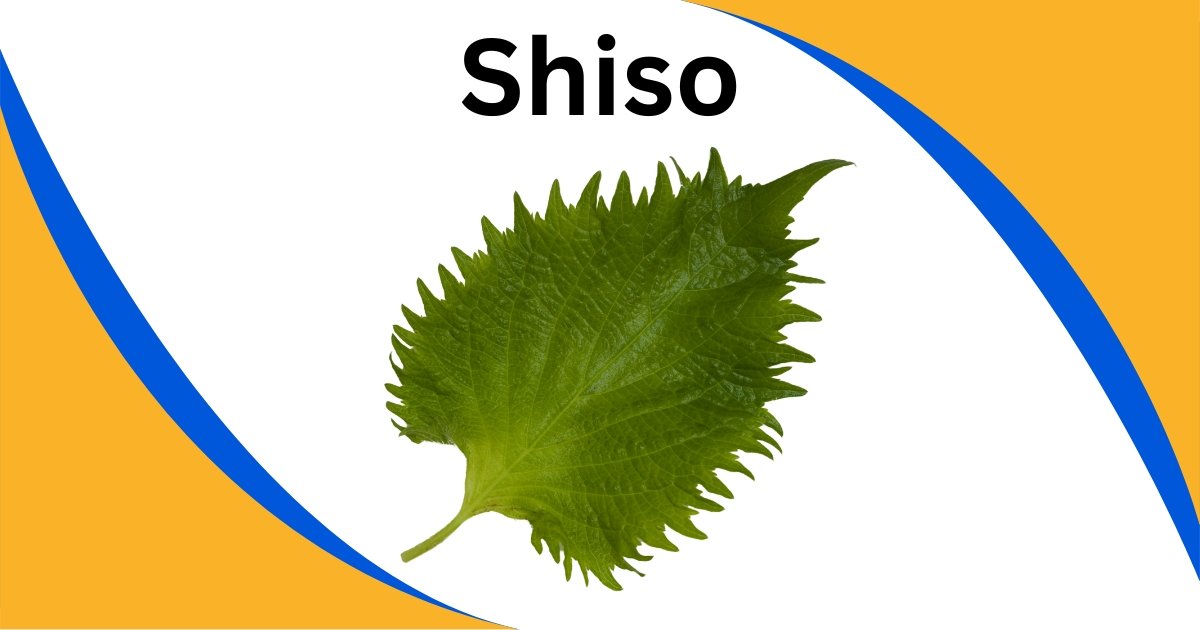Shiso, scientifically known as Perilla frutescens, is a unique herb widely celebrated in Asian cuisine. With its distinctive flavor profile and a myriad of health benefits, shiso has become a staple for chefs and home cooks alike. This blog post will take you on a journey through the fascinating world of shiso, exploring its origins, health advantages, culinary uses, and tips for growing it at home.
What is Shiso?
Shiso is a leafy herb that originates from Asia, particularly in countries like Japan, Korea, and China. Belonging to the mint family, shiso has a distinct aroma that combines the scents of mint and basil, setting it apart from other herbs. There are two primary varieties of shiso: green and purple. The green variety, often referred to as “aojiso,” is commonly used in salads, sushi, and as a garnish, while the purple variety, known as “akasiso,” is often utilized to flavor pickled vegetables and provides a striking visual element to dishes.
Shiso leaves can grow up to five inches long and feature serrated edges. The plant flourishes in warm climates, making it an excellent choice for home gardening. Beyond its culinary appeal, shiso carries a rich history and cultural significance, often being a part of traditional medicine in various Asian societies.
Health Benefits of Shiso
Shiso is not only cherished for its culinary uses but also for its impressive health benefits. The leaves are rich in vitamins A and C, contributing to overall health and well-being. They also contain essential minerals like calcium, potassium, and iron, making shiso a nutritious addition to any meal.
One of the most notable features of shiso is its high antioxidant content. Antioxidants play a crucial role in combating oxidative stress in the body, thereby reducing the risk of chronic diseases. Additionally, shiso possesses anti-inflammatory properties that may help alleviate conditions such as arthritis and other inflammatory disorders.
Another advantage of shiso is its potential to support digestive health. The herb contains compounds that can aid digestion and promote a healthy gut. Many people enjoy shiso tea, made by steeping fresh shiso leaves in hot water, as a soothing beverage that may assist with digestion and relaxation.
Nutritional Profile of Shiso Leaves
To better understand shiso’s health benefits, it’s helpful to look at its nutritional profile. A typical serving of shiso leaves contains about five calories per leaf. They are notably high in vitamin A, which supports vision and immune function, and vitamin C, which aids in collagen production and wound healing. Shiso leaves also offer dietary fiber, which contributes to healthy digestion and promotes gut health. Incorporating shiso into your meals can not only enhance flavor but also boost your overall nutrient intake.
Culinary Uses of Shiso
Shiso is incredibly versatile in the kitchen, with numerous applications that make it a valuable ingredient. Its unique flavor pairs well with a variety of foods, and it can be used both fresh and cooked. One of the most popular ways to enjoy shiso is by adding it to salads. The refreshing taste of shiso complements an array of vegetables and dressings, creating a vibrant dish. Shiso leaves can also be used to wrap sushi, providing a flavorful alternative to traditional nori. The herb enhances the taste of seafood dishes, adding a delightful aroma that elevates the overall dining experience.
If you’re looking to incorporate shiso into your cooking, consider trying a shiso salad by combining fresh leaves with sliced cucumbers, tomatoes, and a light vinaigrette. For a sushi twist, you can use shiso leaves to wrap sushi rolls filled with sushi rice, fresh salmon, and avocado. Another exciting option is to create shiso pesto by blending shiso leaves with garlic, nuts, olive oil, and Parmesan cheese. This unique sauce can be used on pasta, grilled vegetables, or as a spread on sandwiches. These recipes showcase shiso’s versatility, encouraging experimentation in your culinary endeavors.
How to Grow Shiso at Home
Growing shiso at home is a rewarding experience that allows you to enjoy a fresh supply of this delightful herb. Shiso thrives in warm weather and can be cultivated in containers or garden beds. To start, sow shiso seeds indoors about six to eight weeks before the last frost. Once the seedlings reach about three inches tall, you can transplant them outdoors in a sunny location. Shiso prefers well-draining soil rich in organic matter.
It’s important to keep the soil consistently moist but not soggy. Regular watering is crucial, especially during dry spells. You can begin harvesting shiso leaves once the plants are well-established and have several mature leaves. Simply pinch off the leaves at the stem, allowing new growth to continue. Be mindful of common pests like aphids and spider mites; using organic insecticidal soap can effectively manage these pests without harming your plants. By following these steps, you can enjoy fresh shiso leaves right from your own garden.
Shiso vs. Basil: What’s the Difference?
While shiso and basil may appear similar at first glance, they possess distinct characteristics that set them apart in both flavor and culinary uses. Shiso, known for its vibrant green or purple leaves, offers a more complex flavor profile. Many describe its taste as a harmonious blend of mint, basil, and anise, with a slightly peppery undertone. This unique combination makes shiso an exciting ingredient in various dishes, especially in Japanese cuisine, where it is often used in sushi, salads, and garnishes.
In contrast, basil is renowned for its sweeter and more straightforward flavor, which carries a hint of pepper. Commonly associated with Italian and Mediterranean dishes, basil is a staple in recipes like pesto, Caprese salad, and various pasta dishes. The aroma of basil is fragrant yet less robust than that of shiso, making it a versatile choice for lighter dishes.
Understanding these differences is essential for choosing the right herb for your recipes. By knowing when to use shiso or basil, you can ensure that your dishes achieve the best flavor combinations, allowing you to fully enjoy the culinary potential of both herbs.
Where to Buy Shiso
If you’re eager to explore the unique flavor and health benefits of shiso but prefer not to grow it yourself, you’re in luck! Shiso can be found in many Asian grocery stores and specialty markets, especially those that focus on Japanese or Korean ingredients. When shopping for shiso, look for fresh leaves, which are typically sold in bunches. These vibrant green or purple leaves are best used soon after purchase to preserve their aromatic qualities. If fresh shiso isn’t available, you might also find dried shiso products, such as shiso powder or tea, which can still impart that distinctive flavor to your dishes.
For those interested in cultivating this delightful herb at home, numerous online retailers offer shiso seeds for purchase. This option allows you to grow your own shiso plants, ensuring a steady supply of fresh leaves for your culinary adventures. With just a little effort, you can enjoy the satisfaction of harvesting your own shiso. Whether you choose to buy fresh shiso from a local store or grow it in your garden, incorporating this versatile herb into your cooking is an excellent way to elevate your meals and enjoy its health benefits.
FAQs About Shiso
Can you eat shiso leaves raw?
Yes, shiso leaves can be enjoyed raw and are often used as a garnish or in salads, adding a refreshing taste to various dishes.
Is shiso safe for everyone?
Generally, shiso is safe for most individuals; however, some people may have allergies to herbs in the mint family. If you’re trying shiso for the first time, it’s wise to start with a small amount.
How do you store fresh shiso leaves?
To keep fresh shiso leaves, wrap them in a damp paper towel and store them in a plastic bag in the refrigerator. They can last for about a week when stored this way.
Can you freeze shiso leaves?
Yes, you can freeze shiso leaves. Briefly blanch them in boiling water, then cool them in ice water. After drying, place them in airtight bags and store them in the freezer for later use.
What are some other names for shiso?
Shiso is known by various names, including perilla, Chinese basil, and sesame leaf. These names may vary by region and culinary use.
Conclusion
In conclusion, shiso is a remarkable herb that stands out for its unique flavor and numerous health benefits. With its distinct taste profile, shiso can enhance a wide variety of dishes, making it a versatile ingredient in many cuisines. Its culinary uses are only matched by its nutritional value; rich in vitamins A and C, essential minerals, and antioxidants, shiso can contribute positively to your overall health.
Whether you choose to grow this aromatic herb in your garden or purchase it fresh from a local market, shiso is definitely worth exploring. By integrating shiso into your meals, you not only elevate the flavors but also gain the added health advantages it provides.
Moreover, understanding shiso’s uses and its differences from other herbs allows you to appreciate its unique place in culinary arts. This knowledge encourages culinary creativity, enabling you to experiment with various recipes and flavor combinations. Embrace the vibrant and delightful world of shiso in your cooking, and discover how it can transform your meals. For more information and updates on culinary herbs, feel free to visit our homepage, where you can find additional resources and inspiration for your culinary journey.











